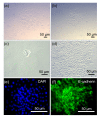Complete disassociation of adult pancreas into viable single cells through cold trypsin-EDTA digestion
- PMID: 23825145
- PMCID: PMC3709064
- DOI: 10.1631/jzus.B1200226
Complete disassociation of adult pancreas into viable single cells through cold trypsin-EDTA digestion
Abstract
The in vitro isolation and analysis of pancreatic stem/progenitor cells are necessary for understanding their properties and function; however, the preparation of high-quality single-cell suspensions from adult pancreas is prerequisite. In this study, we applied a cold trypsin-ethylenediaminetetraacetic acid (EDTA) digestion method to disassociate adult mouse pancreata into single cells. The yield of single cells and the viability of the harvested cells were much higher than those obtained via the two commonly used warm digestion methods. Flow cytometric analysis showed that the ratio of ductal or BCRP1-positive cells in cell suspensions prepared through cold digestion was consistent with that found in vivo. Cell culture tests showed that pancreatic epithelial cells prepared by cold digestion maintained proliferative capacity comparable to those derived from warm collagenase digestion. These results indicate that cold trypsin-EDTA digestion can effectively disassociate an adult mouse pancreas into viable single cells with minimal cell loss, and can be used for the isolation and analysis of pancreatic stem/progenitor cells.
Conflict of interest statement
All institutional and national guidelines for the care and use of laboratory animals were followed.
Figures




Similar articles
-
Improved enzymatic treatment for accurate cell counting from extracellular matrix-rich periodontal ligament cell sheets.Int J Oral Maxillofac Implants. 2014 Jan-Feb;29(1):e117-21. doi: 10.11607/jomi.te50. Int J Oral Maxillofac Implants. 2014. PMID: 24451879
-
Improved quality and yield of islets isolated from human pancreata using a two-step digestion method.Pancreas. 2000 Mar;20(2):184-90. doi: 10.1097/00006676-200003000-00012. Pancreas. 2000. PMID: 10707935
-
Flow Cytometry Method Analysis of Apoptosis: No Significant Difference Between EDTA and EDTA-free Trypsin Treatment Procedure.Technol Cancer Res Treat. 2015 Apr;14(2):237-41. doi: 10.7785/tcrt.2012.500406. Epub 2014 Nov 21. Technol Cancer Res Treat. 2015. PMID: 24502547
-
Fluorescence-activated cell sorting purification of pancreatic progenitor cells.Diabetes Obes Metab. 2008 Nov;10 Suppl 4:179-85. doi: 10.1111/j.1463-1326.2008.00954.x. Diabetes Obes Metab. 2008. PMID: 18834445 Review.
-
Upon a Function of the Pancreas but Little Known; the Digestion of Nitrogenous Food.N Am Medchir Rev. 1859 Jul;3(4):636-640. N Am Medchir Rev. 1859. PMID: 38079811 Free PMC article. Review. No abstract available.
Cited by
-
Nuclear GSK-3β and Oncogenic KRas Lead to the Retention of Pancreatic Ductal Progenitor Cells Phenotypically Similar to Those Seen in IPMN.Front Cell Dev Biol. 2022 May 13;10:853003. doi: 10.3389/fcell.2022.853003. eCollection 2022. Front Cell Dev Biol. 2022. PMID: 35646902 Free PMC article.
-
A novel microfluidic device capable of maintaining functional thyroid carcinoma specimens ex vivo provides a new drug screening platform.BMC Cancer. 2019 Mar 22;19(1):259. doi: 10.1186/s12885-019-5465-z. BMC Cancer. 2019. PMID: 30902086 Free PMC article.
-
Protective Role of Sarpogrelate in Combination with Bromocriptine and Cabergoline for Treatment of Diabetes in Alloxan-induced Diabetic Rats.Curr Ther Res Clin Exp. 2021 Oct 12;95:100647. doi: 10.1016/j.curtheres.2021.100647. eCollection 2021. Curr Ther Res Clin Exp. 2021. PMID: 34777640 Free PMC article.
-
Quantitation of nuclear factor kappa B activation in pancreatic acinar cells during rat acute pancreatitis by flow cytometry.Int J Clin Exp Med. 2015 Jun 15;8(6):10143-51. eCollection 2015. Int J Clin Exp Med. 2015. PMID: 26309713 Free PMC article.
-
DIE-RNA: A Reproducible Strategy for the Digestion of Normal and Injured Pancreas, Isolation of Pancreatic Cells from Genetically Engineered Mouse Models and Extraction of High Quality RNA.Front Physiol. 2018 Feb 27;9:129. doi: 10.3389/fphys.2018.00129. eCollection 2018. Front Physiol. 2018. PMID: 29535635 Free PMC article.
References
-
- Cole RJ, Paul J. The effects of erythropoietin on haem synthesis in mouse yolk sac and cultured foetal liver cells. J Embryol Exp Morphol. 1966;15(2):245–260. - PubMed
Publication types
MeSH terms
Substances
LinkOut - more resources
Full Text Sources
Other Literature Sources

